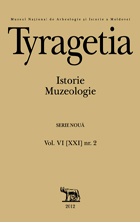Древнерусское искусство на берегах Сены. Заметки о выставке «Святая Русь: Русское искусство с основания до времен Петра Великого» в Лувре в 2010 году
Old Russian art on the shores of Seine. Some notes on the "Holy Russia: Russian Art from the beginning to the times of Peter the Great" exhibition in the Louvre in 2010
Author(s): Yuri PyatnitskySubject(s): History
Published by: Muzeul Naţional de Istorie a Moldovei
Keywords: old Russian art; Louvre exhibition
Summary/Abstract: In the spring of 2010, the Louvre, the largest museum of France, held an exhibition of Russian art that became the most prominent event of the Year of Russia in France. The exhibition was put on a list of official matters and the presidents of both countries opened it in a formal ceremony. The visitors could see in the Louvre’s halls a refined selection of objects of the highest artistic level, an elaborate conception of the exposition’s plan, an excellent design, and a great respect for Russian culture. It took several years for Dr Jannic Durand, a specialist in Byzantine art and Louvre’s curator, and Director Henri Leyrotte to prepare the exhibition. 300 objects from 37 museums and libraries from all around the world, including 26 depositories from Russia, were put on display. It should be emphasized that the main part of the exhibition included the articles of the high artistic level, often the masterpieces. In this article, the author tried to give a virtual tour around the exhibition’s halls in the Louvre, drawing the readers’ attention to the special ways in the displaying the objects, the reasons behind the objects’ selection, and their effect in the exposition space. Special attention is paid to the result (quite often, an unexpected one even for the organizers of the exhibition themselves) reached by the arrangement of the objects in the halls and showcases, their comparison, lighting, and successful design. In some cases, the article explains the motivations behind the selection of the art works that are connected to the ways Old Russian art is perceived by the European public and their interpretation of Russian history. The author is trying to explain not only the ideas that the French organizers of the exhibition wished to reveal in the exhibition halls but also the result of it, and why this result had, in fact, the enormous success among the different categories of visitors.
Journal: Tyragetia (Serie Nouă)
- Issue Year: VI/2012
- Issue No: 2
- Page Range: 365-386
- Page Count: 22
- Language: Romanian

